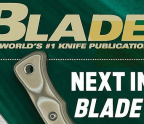IT’S AN AMERICAN THING

IMAGES COURTESY OF THE PARTICIPATING COMPANIES UNLESS OTHERWISE NOTED
If the knife isn’t man’s oldest tool, it’s probably a close second. It has been around in some form since time began. Styles, looks, form and function have steadily evolved, and even though the basics of a particular type may have originated somewhere else, there are those that are associated most closely with the good ol’ USA. These are knife styles that the buying public, the collector, the factory, and the custom maker would probably associate with the United States more closely than any other country.
“You have to start with the time period when knives actually became ‘American,’” explained BLADE Magazine Cutlery Hall of Fame® member Bruce Voyles. “From the first settlers, the Spanish in Florida or the Vikings, every knife they brought to this country was made and came from somewhere else.”
Voyles points to the truly American knife and says that the history of the country allows for a nod to the J. Russell Green River Works in the 1830s—the mountain man period when skinning knives (page 62)
You’re reading a preview, subscribe to read more.
Start your free 30 days





